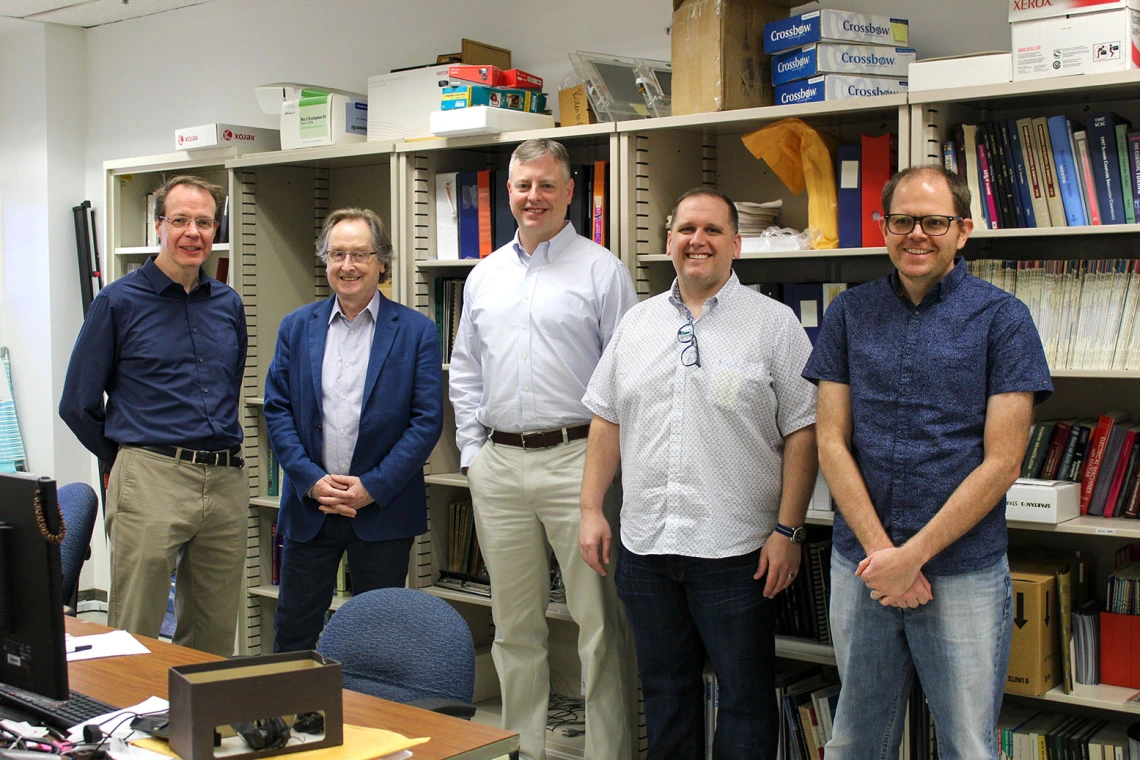From connected cars to pipelines: Engineering innovators aim to protect 'internet of things'
Founded to commercialize inventions from the University of Arizona College of Engineering, BG Networks has set its sights on embedded security automation solutions to keep the world safe from cyberattacks.

The BG Networks team, from left to right: Colin Duggan, Jerzy Rozenblit, Gary Gill, Roman Lysecky, and Sam Winchenbach.
Photo credit: Paul Tumarkin/Tech Launch Arizona
TUCSON, Ariz. – Around the world, countries are on the cyber offense. Researchers from the University of Arizona College of Engineering have invented new strategies to mitigate future cyberattacks by helping make cybersecurity for the "internet of things" (IoT) more accessible for companies and organizations of all sizes. Based on the technology, they have launched a startup, BG Networks, to bring their technology from the UArizona to the public.
All of the interconnected sensors and devices networked together with computers make up the IoT. While our personal items like smart watches, smart doorbells and smart speakers are all part of this network, so are many of the technologies used to manage utility companies and oil pipelines. These later types of entities – those that if brought down have the potential to impact our economy and society – represent prime targets for cyberattackers.
U.S. citizens experienced the realities of such attacks in summer 2021 when attackers targeted systems at the world's largest meat processor, JBS, as well as the computerized equipment that manages the Colonial Pipeline, a 5,500 mile-long pipeline system that transports 3 million barrels of fuel between Texas and New York every day. JBS paid an $11 million ransom to regain control of its systems, and the Colonial Pipeline Company paid a $4 million ransom to restore operations. Any network-connected system is vulnerable to such attacks, including industrial control systems, autonomous vehicles and the power grid.
UArizona researchers have developed a two-part technology – consisting of a Security Automation Tool and an Embedded Security Software Architecture – that allows engineers without cybersecurity backgrounds to implement complex security protocols to prevent such attacks. The team developed security automation tools that work with open-source software to allow engineers to add IoT cybersecurity functions like encryption, authentication and secure software updates quickly and efficiently to their systems.
"Hundreds of thousands of bad actors are at work, and the United States has already seen its share of impactful attacks," said Roman Lysecky, UArizona professor of electrical and computer engineering and co-founder of BG Networks.
Lysecky developed the technology along with BG Networks co-founder and Distinguished Professor of Electrical and Computer Engineering Jerzy Rozenblit, graduate student researcher Aakarsh Rao, former graduate student researcher Nadir Carreon, and professor Johannes Sametinger of Joannes Kepler University Linz in Austria.
"Implementing cybersecurity has always been a complex feat," Lysecky said. "We've developed tools that enable engineers to much more easily and quickly include cybersecurity in their applications."
The team worked with Tech Launch Arizona, the UArizona office that commercializes inventions stemming from university research and innovation, to protect the innovation and develop strategies and skills to position the startup for a successful launch.
"I've been so impressed with this concept and this team," said Doug Hockstad, assistant vice president of Tech Launch Arizona who has a background in software. "The impact that this kind of innovation is positioned to have on society to protect the people and systems we depend upon aligns with the University of Arizona's goals for research – to create impact and improve lives."
"Our vision is to enable IoT security everywhere," said BG Networks co-founder and CEO Colin Duggan, who has 29 years of international leadership, marketing and management experience in the automotive, consumer, industrial and defense markets. "We aim to remove obstacles that prevent embedded engineers from including cybersecurity in their applications."
Paul Tumarkin, Assistant Director, Marketing & Communications
PaulT@tla.arizona.edu
520-626-8770

